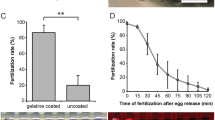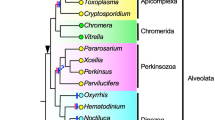Abstract
We used DNA transfection and protein introduction techniques to investigate the pressure tolerance of cytoskeletal structures in pectoral fin cells derived from the deep-sea fish Simenchelys parasiticus (habitat depth, 366–2,630 m). The deep-sea fish cells have G418 resistance. The cell number increased until day 6 of cultivation and all cells had died by day 35 when cultured in 35-mm Petri dishes in medium containing G418. Enhanced yellow fluorescent protein-tagged human β-actin (EYFP-actin) was stably expressed by 1 in 100,000 deep-sea fish cells. Because almost none of the EYFP-actin was incorporated into actin filaments of the cells, we replaced the relatively large EYFP tag with a chemical fluorescent compound and succeeded in incorporating fluorescently labeled rabbit actins into the deep-sea fish actin filaments. Most of the filament structure in the cells with rabbit actin inserted underwent depolymerization when subjected to pressure of 100 MPa for 20 min, in contrast to control cells. There were no differences in the tubulin filament structure between control cells and deep-sea fish cells with fluorescein-labeled bovine tubulin inserted after the application of pressure ranging from 40 to 100 MPa for 20 min.





Similar content being viewed by others
References
Alberts B, Johnson A, Lewis J, Raff M, Roberts K, Walter P (eds) (2002) Molecular biology of the cell, 4th edn. Garland Science, New York
Bar-Num S, Shneyour Y, Beckmann J (1983) G-418, an elongation inhibitor of 80S ribosomes. Biochim Biophys Acta 741:123–127
Bourns B, Franklin S, Cassimeris L, Salmon ED (1988) High hydrostatic pressure effects in vivo: changes in cell morphology, microtubule assembly, and actin organization. Cell Motil Cytoskeleton 10:380–390
Crenshaw HC, Allen JA, Skeen V, Harris A, Salmon ED (1996) Hydrostatic pressure has different effects on the assembly of tubulin, actin, myosin II, vinculin, talin, vimentin, and cytokeratin in mammalian tissue cells. Exp Cell Res 227:285–297
Davies J, Jimenez A (1980) A new selective agent for eukaryotic cloning vectors. Am J Trop Med Hyg 29:1089–1092
Davis JS (1981) Pressure-jump studies on the length regulation kinetics of the self-assembly of myosin from vertebrate skeletal muscle into thick filament. Biochem J 197:309–314
Davis JS (1985) Kinetics and thermodynamics of the assembly of the parallel- and antiparallel-packed sections of synthetic thick filaments of skeletal myosin: a pressure-jump study. Biochemistry 24:5263–5269
Horikoshi K, Tsujii K (1999) Extremophiles in deep-sea environments. Springer, Tokyo
Koyama S, Aizawa M (2000) Tissue culture of the deep-sea bivalve Calyptogena soyoae. Extremophiles 4:385–389
Koyama S, Miwa T, Sato T, Aizawa M (2001) Optical chamber system designed for microscopic observation of living cells under extremely high hydrostatic pressure. Extremophiles 5:409–415
Koyama S, Miwa T, Horii M, Ishikawa Y, Horikoshi K, Aizawa M (2002) Pressure-stat aquarium system designed for capturing and maintaining deep-sea organisms. Deep-Sea Res I 49:2095–2102
Koyama S, Horii M, Miwa T, Aizawa M (2003a) Tissue culture of the deep-sea eel Simenchelys parasiticus collected at 1,162 m. Extremophiles 7:245–248
Koyama S, Horii M, Miwa T, Aizawa M (2003b) Erratum. Extremophiles 7:340
Koyama S, Kobayashi H, Inoue A, Miwa T, Aizawa M (2005a) Effects of the piezo-tolerance of cultured deep-sea eel cells on survival rates, cell proliferation, and cytoskeletal structures. Extremophiles 9:449–460
Koyama S, Nagahama T, Ootsu N, Takayama T, Horii M, Konishi S, Miwa T, Ishikawa Y, Aizawa M (2005b) Survival of deep-sea shrimp (Alvinocaris sp.) during decompression and larval hatching at atmospheric pressure. Mar Biotechnol 7:272–278
Landau JV (1960) Sol–gel transformations in fibroblasts of embryonic chick heart tissue: a pressure-temperature study. Exp Cell Res 21:78–87
Landau JV (1961) The effects of high hydrostatic pressure on human cells in primary and continuous culture. Exp Cell Res 23:538–548
Morita T (2003) Structure-based analysis of high pressure adaptation of α-actin. J Biol Chem 278:28060–28066
Nakabo T (2000) Fishes of Japan with pictorial keys to the species, 2nd edn. Tokai University Press, Tokyo
Salmon ED (1975) Pressure-induced depolymerization of brain microtubules in vitro. Science 189:884–886
Swezey R, Somero GN (1985) Pressure effects on actin self-assembly: interspecific differences in the equilibrium and kinetics of the G and F transformation. Biochemistry 24:852–860
Wilson RG Jr, Trogadis JE, Zimmerman S, Zimmerman AM (2001) Hydrostatic pressure induced changes in the cytoarchitecture of pheochromocytoma (PC-12) cells. Cell Biol Int 25:649–666
Author information
Authors and Affiliations
Corresponding author
Rights and permissions
About this article
Cite this article
Koyama, S., Aizawa, M. Piezotolerance of the cytoskeletal structure in cultured deep-sea fish cells using DNA transfection and protein introduction techniques. Cytotechnology 56, 19–26 (2008). https://doi.org/10.1007/s10616-007-9099-7
Received:
Accepted:
Published:
Issue Date:
DOI: https://doi.org/10.1007/s10616-007-9099-7




